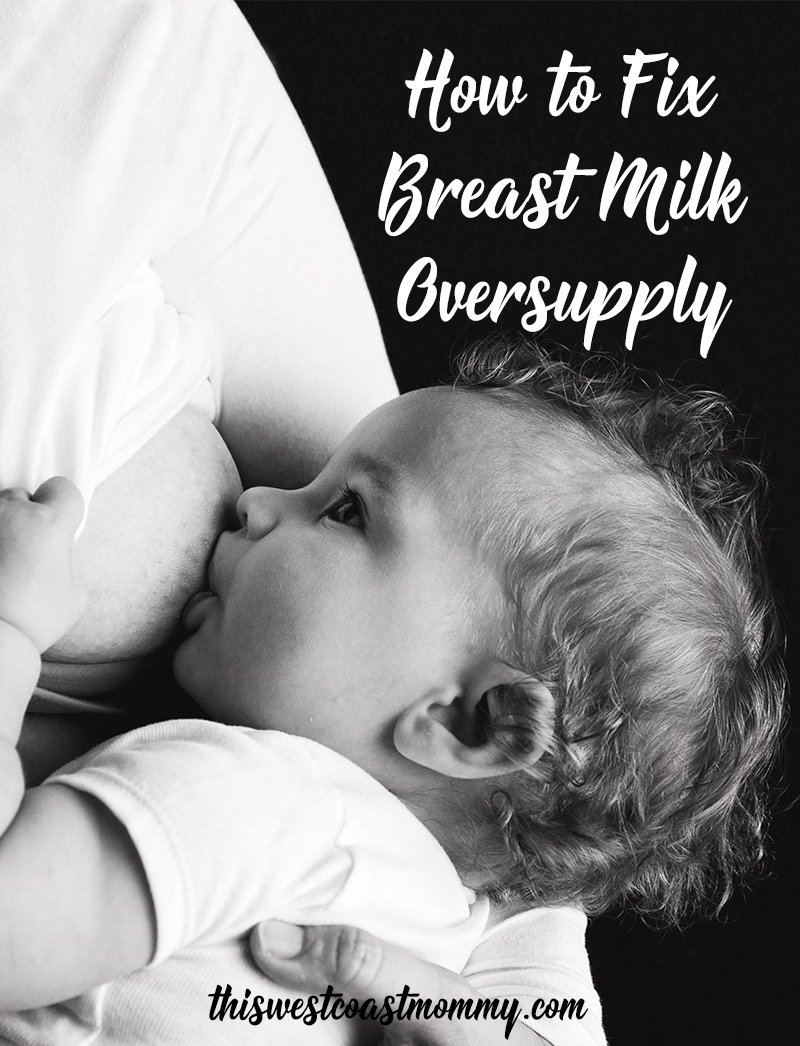Seven years ago when Tee was born, I received the standard breastfeeding advice to feed from both breasts every feeding, about 10 minutes on each side. As a first-time mom I desperately wanted to do everything “right”, so that’s what I did.

As any new mom can relate, my boobs hurt when my milk came in. But instead of getting better, mine continued to feel sore and overly full, days and even weeks after. And Tee was fussy all the time. She sputtered and gagged every time we fed, she spit up a lot, and she passed freaky green frothy poops. The best way I can describe it is it looked like she’d pooped a spinach smoothie in her diaper. What was wrong with my baby? What was wrong with me?
I knew that many moms struggled with low supply. I’d read lots of stories from moms who couldn’t make enough milk. I’d seen recipes all over my favourite parenting blogs for lactation cookies and milk making tea. Eat oatmeal! Drink dark beer! Take fenugreek!
What nobody told me was that breast milk oversupply could be a problem too. My baby was sputtering and gagging because the force of my super milk letdown was too much for her to swallow. She was having digestive trouble because she was getting way too much watery foremilk instead of the higher fat hindmilk that fills and satisfies baby tummies. And having constantly full breasts gave me frequent plugged ducts.
Foremilk vs. Hindmilk
Here’s how it works. When you breastfeed, the first part of the milk (foremilk) that gets drawn out is thin and watery and slightly bluish like skim milk. This is the milk that satisfies your baby’s thirst. As your baby keeps nursing, that watery milk gradually turns into higher fat hindmilk. This hindmilk is rich, creamy, and high in fat (giving it its yellowish hue). This is the milk that fills up baby’s tummy and satisfies her hunger. Foremilk is higher in lactose, so if baby is getting too much of it, it can cause gassiness, tummy pain, and those frothy green poops.

I didn’t realize it at the time, but every time I switched breasts halfway through a feeding (as I had been taught to do), I was filling her up with foremilk. She never had the chance to finish the breast and get the richer hindmilk behind the foremilk. And because breast milk production works on supply and demand, every time I switched breasts I was telling my body to make more milk!
I struggled like this for a few weeks until I finally stumbled on the concept of block feeding.
What is Block Feeding?
Block feeding, or block nursing, is a different kind of nursing schedule. When you block feed, you nurse your baby from one breast only for a certain block of time, regardless of how many feedings occur during that time. We started out on a 3-hour schedule. So from 8am-11 am, I fed Tee on my left breast only. Then from 11 am-2 pm, we switched to my right breast only. Then back to the left breast for the next 3-hour block, and so on.

I won’t lie. It hurt for the first few days. As I fed from the one breast only, the other one filled up and became engorged. I leaked a lot. The first feed in any block was horrible. My breasts would get so engorged that Tee sometimes couldn’t even get a latch. I learned to hand express some milk out before that feed, just enough to soften my breast enough so she could latch on. For the first few days, I also nursed lying back with Tee on my chest so the milk had to travel against gravity and reduce the force of my letdown when she nursed.
Those uncomfortably full breasts signalled my body to ease back on the milk though, and once my milk production was brought under control over the course of about a week, I was able to switch to a simpler schedule of nursing from just one breast per feeding. At first I used a little clip on my bra (like this one) to remind me which side I’d just nursed on. Switching a hair elastic between my wrists worked well too. But I soon figured out it was easy to tell just by squeezing each boob to see which one felt fuller. We kept up this nursing pattern throughout our entire breastfeeding relationship, and these tools for treating breast milk oversupply worked like a charm when my second baby came along.
Have you experienced breast milk oversupply? How did you handle it?
Visit La Leche League for more info on treating oversupply issues.









I had the same issue and struggled with my first two using many of the same methods you describe. With my third, I discovered peppermint oil! It was like magic in those early days of rock hard breasts and leaky boobs. A few drops in a roller bottle with coconut oil as a carrier. A small swipe was all it took to get a little relief until I leveled off. Just had to be careful not to use to much and dry up completely.
Interesting! I’d heard that drinking peppermint tea can help reduce supply, but I hadn’t heard that about topical EO use.
How long did you block feed for before you noticed a change? I’m in the process now and worrying it might be a dairy or soy allergy in addition to the oversupply.